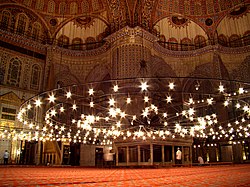It was built between 1609 and 1616, during the rule of Ahmed I. Like many other mosques, it also comprises a tomb of the founder, a madrasah and a hospice. While still used as a mosque, the Sultan Ahmed Mosque has also become a popular tourist attraction of Istanbul.
Architecture
Interior
Aits lower levels and at every pier, the interior of the mosque is lined with more than 20,000 handmade ceramic tiles, made at Iznik (the ancient Nicaea) in more than fifty different tulip designs. The tiles at lower levels are traditional in design, while at gallery level their design becomes flamboyant with representations of flowers, fruit and cypresses. More than 20,000 tiles were made under the supervision of the Iznik master potter Kaşıcı Hasan,and Mustafa Mersin Efendi from Avanos(Cappadocia). The price to be paid for each tile was fixed by the sultan's decree, while tile prices in general increased over time. As a result, the quality of the tiles used in the building decreased gradually. Their colours have faded and changed (red turning into brown and green into blue, mottled whites) and the glazes have dulled. The tiles on the back balcony wall are recycled tiles from the harem in the Topkapı Palace, when it was damaged by fire in 1574.The upper levels of the interior are dominated by blue paint, but it is of poor quality. More than 200 stained glass windows with intricate designs admit natural light, today assisted by chandeliers. On the chandeliers, ostrich eggs are found that were meant to avoid cobwebs inside the mosque by repelling spiders[2]. The decorations include verses from the Qur'an, many of them made by Seyyid Kasim Gubari, regarded as the greatest calligrapher of his time. The floors are covered with carpets, which are donated by faithful people and are regularly replaced as they wear out. The many spacious windows confer a spacious impression. The casements at floor level are decorated with opus sectile. Each exedra has five windows, some of which are blind. Each semi-dome has 14 windows and the central dome 28 (four of which are blind). The coloured glass for the windows was a gift of the Signoria of Venice to the sultan. Most of these coloured windows have by now been replaced by modern versions with little or no artistic merit.
The most important element in the interior of the mosque is the mihrab, which is made of finely carved and sculptured marble, with a stalactite niche and a double inscriptive panel above it. The adjacent walls are sheathed in ceramic tiles. But the many windows around it make it look less spectacular. To the right of the mihrab is the richly decorated minber, or pulpit, where the Imam stands when he is delivering his sermon at the time of noon prayer on Fridays or on holy days. The mosque has been designed so that even when it is at its most crowded, everyone in the mosque can see and hear the Imam.
The royal kiosk is situated at the south-east corner. It comprises a platform, a loggia and two small retiring rooms. It gives access to the royal loge in the south-east upper gallery of the mosque. These retiring rooms became the headquarters of the Grand Vizier during the suppression of the rebellious Janissary Corps in 1826. The royal loge (hünkâr mahfil) is supported by ten marble columns. It has its own mihrab, that used to be decorated with a jade rose and gilt [3] and one hundred Qurans on inlaid and gilded lecterns. [4]
The many lamps inside the mosque were once covered with gold and gems [5]. Among the glass bowls one could find ostrich eggs and crystal balls [6]. All these decorations have been removed or pillaged for museums.
The great tablets on the walls are inscribed with the names of the caliphs and verses from the Quran, originally by the great 17th-century calligrapher Ametli Kasım Gubarım, but they have frequently been restored
Minarets
The Blue Mosque with all six minarets visible.
Four minarets stand at the corners of the mosque. Each of these fluted, pencil-shaped minarets has three balconies (ṣerefe) with stalactite corbels, while the two others at the end of the forecourt only have two balconies.
Until recently the muezzin or prayer-caller had to climb a narrow spiral staircase five times a day to announce the call to prayer. Today a public address system is used, and the call can be heard across the old part of the city, echoed by other mosques in the vicinity. Large crowds of both Turks and tourists gather at sunset in the park facing the mosque to hear the call to evening prayers, as the sun sets and the mosque is brilliantly illuminated by colored floodlights.



Hiç yorum yok:
Yorum Gönder